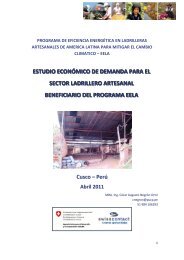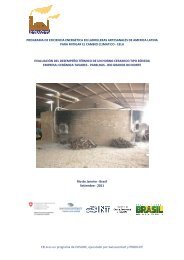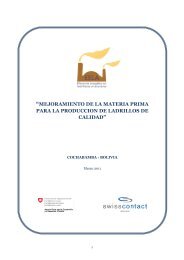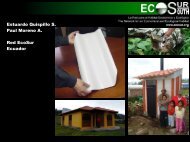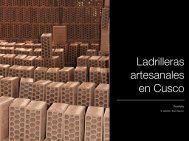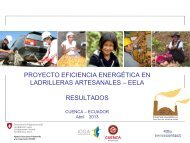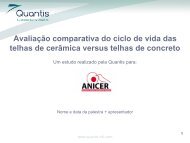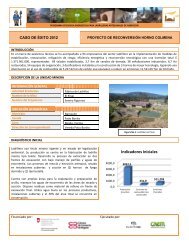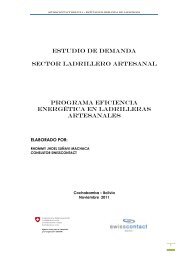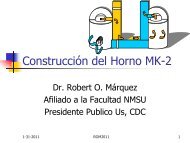A Roadmap for Cleaner Brick Production in India - Red Ladrilleras
A Roadmap for Cleaner Brick Production in India - Red Ladrilleras
A Roadmap for Cleaner Brick Production in India - Red Ladrilleras
- No tags were found...
Create successful ePaper yourself
Turn your PDF publications into a flip-book with our unique Google optimized e-Paper software.
Environment Per<strong>for</strong>manceThe environmental per<strong>for</strong>mance results are presented below.Suspended Particulate MatterSuspended Particulate Matter (SPM)is a term used <strong>for</strong> airborne particles ofdiameter less than100 µm. The emission factor <strong>in</strong> terms of g/kg of fired brick <strong>for</strong> SPM is presented <strong>in</strong> Table 5.VSBK had the lowest SPM emission factor,followed by zig-zag kiln, tunnel kiln, FCBTK andDDK, respectively. Due to the addition of powdered fuel with the clay and steady-statecombustion conditions, VSBK and tunnel kilnswere among the lowest emitters of SPM.Better combustion conditions resulted <strong>in</strong> lower SPM <strong>in</strong> properly operated zig-zag kilnscompared to FCBTKParticulate Matter (PM 2.5 )Emission norms <strong>in</strong> <strong>India</strong> do not address PM 2.5 specifically, but it is frequently monitoredbecause of its environmental and health effects. F<strong>in</strong>e particulate matter (diameters less than2.5 µm) can penetrate more deeply <strong>in</strong>to lungs than larger particles. It also has a longeratmospheric lifetime and a disproportionately greater effect on visibility and climate,relativeto larger particles. VSBK technology had the lowest PM 2.5 emissions, and DDKhad thehighest PM 2.5 emissions.Gaseous PollutantsKilns were monitored <strong>for</strong> sulphur dioxide (SO 2 ), oxides of nitrogen (NO x) carbon monoxide(CO) emissions and carbon dioxide (CO 2 ). Table 5 provides the emission factors <strong>for</strong> variouspollutants monitored <strong>in</strong> the study, normalized to grams of pollutant/kg of fired brick.SO 2 emissions stem from the sulphur content of fuel,there<strong>for</strong>e significant variation <strong>in</strong> theSO 2 concentration were observed <strong>in</strong> the monitored kilns. SO 2 concentration was lowest <strong>in</strong>down draft kiln,which uses biomass fuel,with negligible sulphur content.NO x emissions were generally very low and below the detectable levels.Emissions of carbon monoxide (CO) are an <strong>in</strong>dication of <strong>in</strong>complete combustion of fuel. Zigzagkilns hadthe lowest CO emissions. With<strong>in</strong> the zig-zag technology, the monitored naturaldraught zig-zag kiln had much lower CO emissions as compared to the monitored <strong>for</strong>ceddraught zig-zag kiln. Good fuel-feed<strong>in</strong>g and operat<strong>in</strong>g practices support this improvement.CO 2 emissions are directly related to the SEC and carbon content of fuels be<strong>in</strong>g used <strong>in</strong> thekiln. Hence the CO 2 emissions show similar rank<strong>in</strong>g hierarchy as <strong>for</strong> SEC.12



